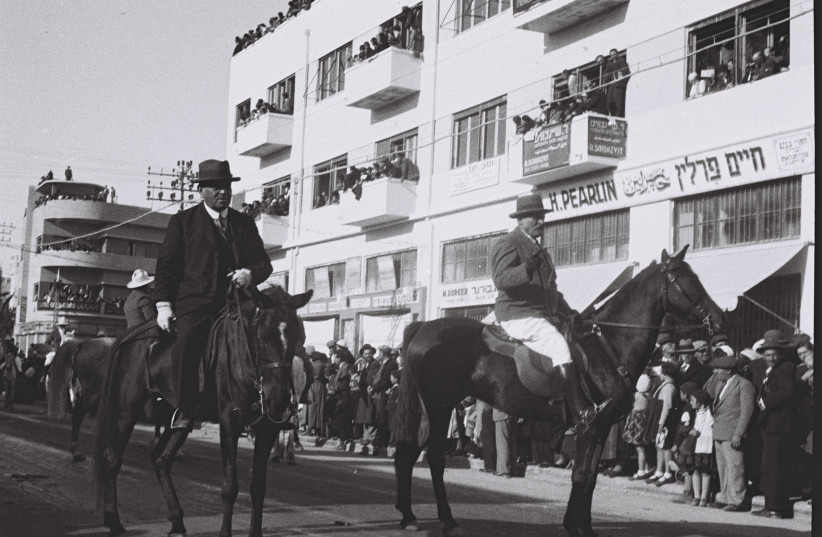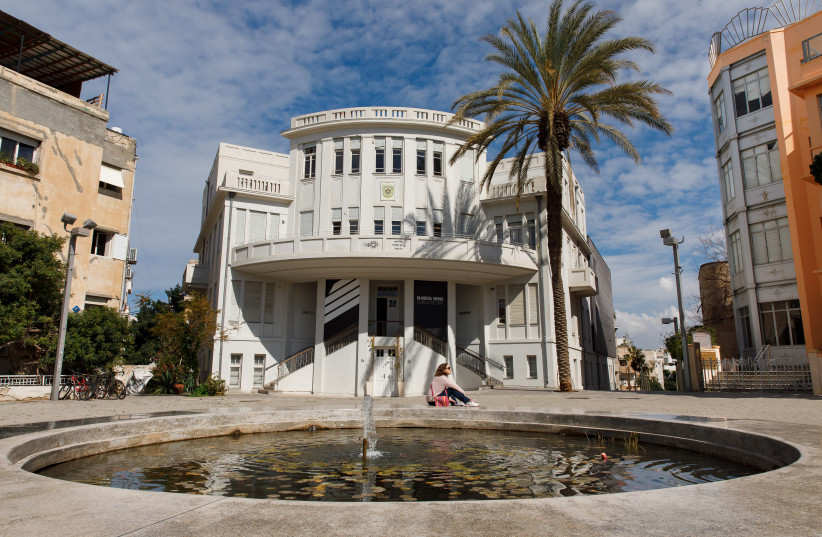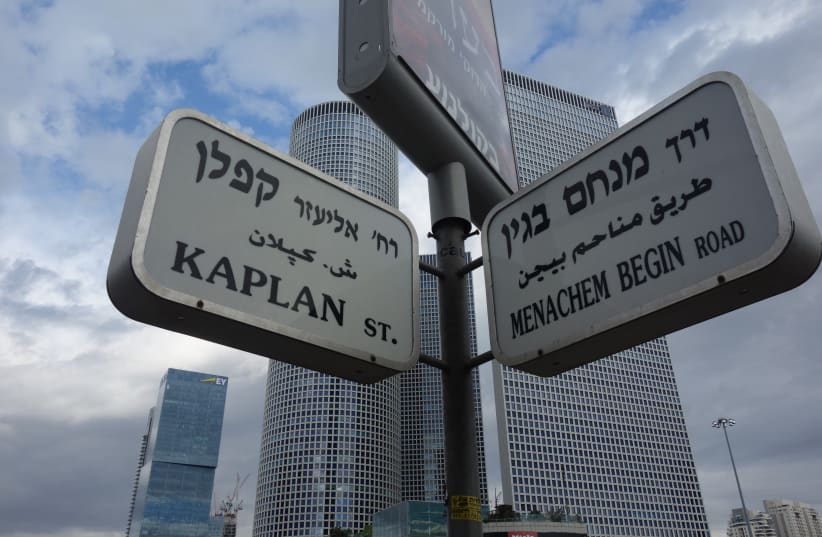Tel Aviv is a bona fide metropolis. There’s no arguing with the vibe that exudes from almost every corner of the urban sprawl, across the rapidly stirring downtown area to the center, across to hip Florentin, back up to the northern reaches of the city, and out to the seafront and farther south to Jaffa.
It is a buzzing cosmopolitan magnet for culture consumers, businesspeople, shoppers and fans of epicurean delights of all sorts.
However, how many of us, as we head to our favored watering hole, trundle along one of the broad tree-lined boulevards or make our way down one of the quieter side streets, consider the documentary backdrop that resonates in our route of choice?
Years back, should we have bothered to take a few moments out of our rat race trajectory, we could have read a brief bio description on the metal blue street name sign and, for example, learned a couple of things about who Ahad Ha’am was or Chaim Arlozorov. These days the more utilitarian name signs, with black lettering on a plastic white base, merely note the street name in Hebrew, Arabic and English. Practical but not particularly enlightening.


The history behind the names of Tel Aviv's streets
If your interest in the first Jewish city in modern times stretches beyond quotidian leisure and breadwinning activities, and you’d like to get a half-decent handle on Tel Aviv’s – and, indeed, the country’s – history, you might want to delve into a new book with a rather wordy title. 50 of Tel Aviv’s Most Intriguing Streets – The Lives Behind the Names may not be in the running for the definitively concise publication moniker, although it certainly spells out what you can expect to find inside the covers.
50 of Tel Aviv’s Most Intriguing Streets – for practical purposes we’ll make do with an abbreviated version of the title – is a handsome tome, put out by the Jerusalem-based Gefen Publishing House. The principal ground-level movers behind the publication include photographer Ziv Koren, whose color shots help to catch the eye and skillfully impart an immediate sense of the urban zeitgeist. New York-born longtime olah Miryam Sivan compiled the fascinating and highly informative textual content, while Ellin Yassky made sure all the component parts came together in polished, seamless fashion.
MOST OF US, presumably, know who Chaim Weizmann and Eliezer Ben-Yehuda were. Both are weightily commemorated in Tel Aviv’s mesh of city center arteries. But what about, for example, Moshe Leib Lilienblum? Despite having been a resident of Tel Aviv and its environs for over a decade, quite a few years ago now, I had no idea that the gent whose name graces the important street near the southern end of Allenby Street was, in fact, a Lithuanian-born 19th-century writer and Zionist activist and a driving force behind the Hovevei Zion movement.
I wasn’t the only ignoramus. Stephen Saft, who is succinctly and colorfully described in the book acknowledgments as “An American Jew who loves Israel, the Jewish people and the ever-changing mosaic called Tel Aviv,” frequented a café on Lilienblum Street for some years before he eventually got around to checking the eponymous character out. That proved to be the catalyst for the new publication.
That leads to how Sivan got in on the act. “I didn’t know who all these people [in the street names] were,” she says. “I knew some of them, the more obvious ones like King George. The British names. I also didn’t know who Lilienblum was.”
“I knew some of them, the more obvious ones like King George. The British names. I also didn’t know who Lilienblum was.”
Miryam Sivan
I empathized and confessed I didn’t know who Isaac Dov Berkowitz was, referencing the cozy residential street that runs around the Golda Center, the arts and culture hub that takes in the Performing Arts Center, Tel Aviv Museum and Beit Ariela Municipal Library.
“Ah, him I knew because it’s literature,” Sivan chuckles.
For the uninitiated who, unlike me, have yet to lay their hands on 50 of Tel Aviv’s Most Intriguing Streets, Berkowitz was a Vilna-born man of Hebrew and Yiddish letters, who helped to popularize the works of Sholem Aleichem and who relocated to New York in the early 20th century, and subsequently to British Mandate Palestine. In his 1904 story “The Uprooted,” he put into succinct words the sense of alienation felt by many young Jews of the time.
The project is a natural development for Sivan. Although Big Apple-born and bred, she has deep roots in this part of the world.
“My mother was born here; my grandparents lived two streets away from here,” she says, pointing a thumb west of Dizengoff Square, where we settled down to chat. “I have only been living in Tel Aviv seven years, but I spent many summer vacations here as a kid.”
Our choice of rendezvous locale provided a neat case in point that amplified the aesthetics that jump out at you from almost every page in the book. Koren’s deftly crafted photographs serve as a tasteful and informative counterpoint to the archival pictorial items.
The Bialik Street and Chen Boulevard hybrid installment has a pretty nuts-and-bolts, yet compelling, shot of the former municipality building at the end of Bialik Street. That is flanked by a 1930s view of the street looking west toward Allenby Street and the fountain that once graced the cul-de-sac square, balanced by a frame taken from the Allenby end, in 1935, with one of the city’s first European-style eateries, Café Sapir, to the right. The presence of diminutive figures of Tel Avivites going about their business helps to depict the yesteryear spirit.
THE ENTRIES on even the better known Zionist pioneers in the book add to one’s knowledge of Tel Aviv and the state. The name Meir Dizengoff is surely familiar to most. As a resident of the city all those years ago, I was among those who periodically went out for a Shabbat window shopping stroll along one of the city’s three major thoroughfares – the other two were Ben-Yehuda Street and Allenby Street – in an activity then called “lehizdangeff,” thus crediting the city’s first mayor with an albeit unauthorized Hebrew verb all of his own.
Those days are long gone, but the book still manages to impart a time capsule feel, set against the very different vibes, mindset and pace of the here and now.
Actually, considering the way the Tel Aviv authorities generally approach the planning and restoration of the city’s veteran architectural gems, that should not come as a surprise.


Mind you, of course that was very much encouraged by UNESCO’s decision, in 2003, to add the White City of Tel Aviv’s unique collection of Bauhaus buildings, which number in excess of 4,000, to the list of World Heritage Sites. But that accommodating and respectful ethos had been very much in evidence in the city for some time before that, as indicated by a number of Ottoman-era edifices on and near Allenby Street.
That is exemplified in the book, in the Rothschild Boulevard slot, where Koren’s keen eye for context captures the fetching eclectic-style creation at No. 46, known as Levine House. We are told the building was designed by Yehuda Magidovitch back in 1924 and that during the course of the past close to a century, it has served, inter alia, as the Soviet Embassy and as the local Sotheby’s auction house.
Which neatly brings us back to my parley with Sivan and the very same Ukrainian-born Magidovitch, who was one of the most prolific professionals in his field in these parts. His extensive portfolio included the legendary Galei Aviv Casino, which stood on Tel Aviv’s beachfront, near what is now Herbert Samuel Square, from 1924 to 1939. More to the geographical point, for Sivan’s and my juncture, is the Esther Cinema, which Magidovitch also designed. The movie theater, which both Sivan and I remember frequenting over the years, was built in 1938 and enjoyed an extended entertainment run before being converted into the Cinema Hotel 60 years on. “That’s just over there,” says Sivan. “Right on Dizengoff Square.”
ANOTHER INTERESTING informative tidbit you get from the book is that the famed square, which sits on the thoroughfare that commemorates Meir Dizengoff, is, in fact, named after his wife, Zina.
The circular urban space has quite a checkered history, having been elevated above street level in the 1970s to allow traffic to flow in a straight line. A decade or so later, the original fountain sculpture was replaced by the far more spectacular Fire and Water work by now 94-year-old Yaacov Agam, with its striking multihued rotating drums and the hourly display of spurting water and scarcely believable incorporation of flames.
Around four years ago the square was returned to terra firma, and the Agam work, which had been banished to some remote part of the city for a while, was relocated back to its original site. The rotating parts have yet to be restored to their former colorful glory, but, I have been told, that is in the pipeline.
The late Mrs. Dizengoff is not the only woman to get her municipal salute, although male street names still far outnumber the distaff side. The book notes streets named after Hannah Semer, the country’s first female editor-in-chief, and Marks & Spencer department store chain heiress Rivka Sieff, whose extensive philanthropic work includes establishing WIZO (the Women’s International Zionist Organization). Henrietta Szold, founder of Hadassah, the Women’s Zionist Organization of America, is also featured. The two-page spread about her, and the street that bears her name, poignantly includes an archival photograph of her surrounded by the founding physicians of Hadassah Hospital on Mount Scopus. Szold is the only woman in the group.
“In the older parts of Tel Aviv, there are very few women [on street names],” Sivan points out. “I insisted they all be in the book.” Things, thankfully, have improved on that score. “In the newer parts of Tel Aviv, in the north [Ramat Aviv and its environs], there are many more [streets named after women].”
That issue comes into the sphere of what Sivan calls “the political dimension” of street naming. “I talk about that in the introduction to the book,” she says. In that regard there is a morsel of small comfort to be had in that it is not a uniquely Israeli deficiency. “It is the same all over the world,” Sivan adds. “Street names tell a story. They are a narrative.”
That is not a uniquely gender-lopsided area. “They reflect the people that choose the names. Driving around Tel Aviv, I realized that everyone [in the street names] is Ashkenazi, dead white men, as they say in America,” Sivan chuckles. “When we got Neveh Tzedek [in the book compilation], I insisted that we have Shalom Shabazi Street. Not only is it an important street and a major street for Neveh Zedek, Shabazi is like a Shakespeare from Yemen,” she says of the 17th-century poet. “We had to have that in.”
Considering the size of contemporary Tel Aviv and the tendency we have in this country to celebrate our forefathers and foremothers in street names, it was no simple task deciding who makes the publication cut. “These are 50 streets out of hundreds,” Sivan observes. “So how do you begin to whittle it down?”
But whittle Sivan and her colleagues duly did, and they ended up with a fine-looking, illuminating coffee table-proportioned tome. Makes for fine viewing and an enlightening read.
For more information: www.gefenpublishing.com
